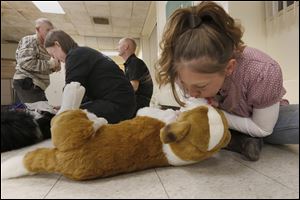
Humans get house-trained in emergency pet care
Dog first-aid class goes on test run at Lucas Co. shelter
1/24/2014
Lucas County Canine Care & Control volunteer Jackie Stephan learns to resuscitate a dog, using a stuffed animal. during the course.
Several of the nine adults at the Lucas County Canine Care & Control couldn’t help but joke and laugh as they practiced cardiopulmonary resuscitation on specialized stuffed dogs.
Run by the American Red Cross, the county shelter on Wednesday night organized a dog first-aid course for its staff and volunteers as a trial run for a possible recurring class to be offered to the public.
“It’s a little like in-house training this time to see if it’s something we can do,” Laura Simmons, community outreach coordinator, said. “But we want to be able to do this a couple of times a year for the public.”
The course is part of the county shelter’s efforts to reach out to the community and to help people better care for their pets.
“We want to provide opportunities for the community to become more knowledgeable dog owners,” Ms. Simmons said.
Tom Quinn, a Red Cross instructor from the Akron branch, said animals can have medical emergencies just like people. Having some idea of what to do can help pet owners stay calm and care for their animals.
“You never know when things might happen, but they do happen,” Mr. Quinn said. “You hope you never would have to use it, but it’s good to know.”
Basic first-aid such as bandaging and splinting, as well as more advanced techniques such as CPR, can help stabilize an animal’s condition and possibly save its life before it can be seen by a veterinarian.
“They are very important skills to have if you are around animals a lot,” Ms. Simmons said.
Some of the shelter staff, such as canine control officer Annie Connolly, have taken pet first-aid courses.
“This is a good refresher,” Ms. Connolly said. “It helps keep us up-to-date.”
In the field, the officers might use first-aid to help an injured dog before it is taken to either the shelter veterinarian or to an emergency clinic.
“We do the first initial on-scene treatment and get them to the next step,” Ms. Connolly said. “But we have to be careful. They could be startled, upset, in pain, in shock, and then they have someone in their face. Most animals, when they’re injured, are afraid. Some of the worst bites you can get from an animal are from when they’re afraid.”
Sylvania Township resident Omar Smiley is a volunteer at the county shelter and a foster parent for the Lucas County Pit Crew. He has never taken a first-aid course, either for humans or for animals.
“Any new information or knowledge I can get helps me better understand how to better take care of my dogs,” he said.
He was thinking of his young foster dog in particular, a “pit-bull” mix named Cotter who has a habit of hurting himself slightly while he plays.
“He’s always crashing into things and getting scratched all over,” Mr. Smiley said.
Cotter’s injuries thus far have been minor, but he could someday get into bigger trouble and need help. Knowledge of basic dog first-aid could come in handy.
“It’s at least good to have an idea of what to do,” Mr. Smiley said.
Contact Alexandra Mester: amester@theblade.com, 419-724-6066, or on Twitter @AlexMesterBlade.